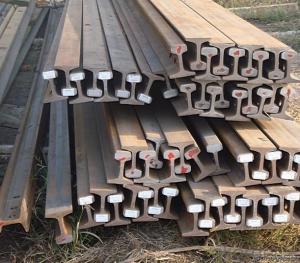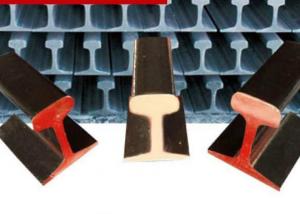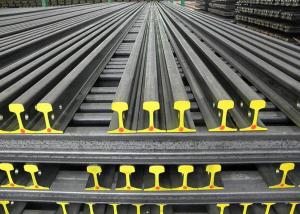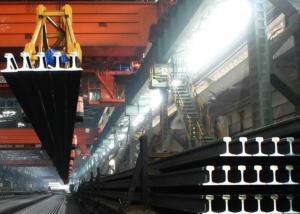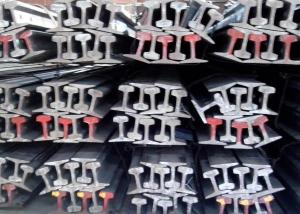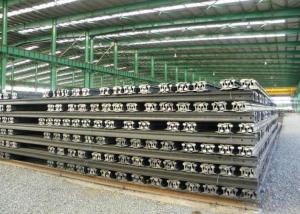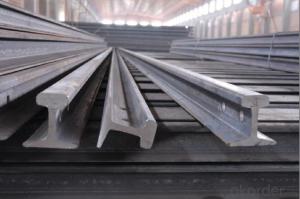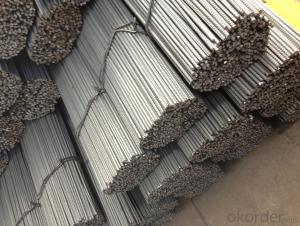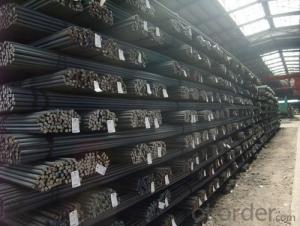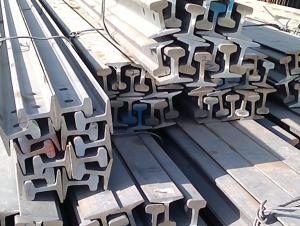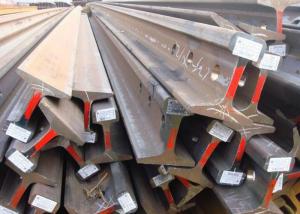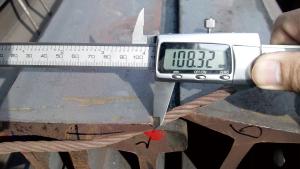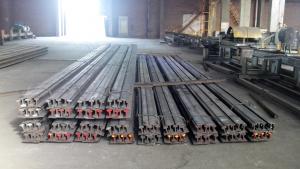Light Railway Steel Rail GB Standard
- Loading Port:
- China Main Port
- Payment Terms:
- TT or LC
- Min Order Qty:
- 50 m.t.
- Supply Capability:
- 5000 m.t./month
OKorder Service Pledge
OKorder Financial Service
You Might Also Like
Product Description:
OKorder is offering Light Railway Steel Rail GB Standard at great prices with worldwide shipping. Our supplier is a world-class manufacturer of steel, with our products utilized the world over. OKorder annually supplies products to African, South American and Asian markets. We provide quotations within 24 hours of receiving an inquiry and guarantee competitive prices.
Product Applications:
Light Railway Steel Rail GB Standard are ideal for structural applications and are widely used in forest region, Mines, factories and construction sites laid of the place such as temporary transport line and light motorcycles with line.etc.
Product Advantages:
OKorder's Light Railway Steel Rail GB Standard are durable, strong, and wide variety of sizes.
Main Product Features:
· Premium quality
· Prompt delivery & seaworthy packing (30 days after receiving deposit)
· Mill test certification
· Professional Service
· Competitive pricing
Product Specifications:
Manufacture: Hot rolled
Grade: Q235, 55Q
Certificates: ISO, SGS, BV, CIQ
Length:6m, 12m,12.5m
Package: Packed in bundles and shipped by break bulk or containers.
Trademark | Rank | Chemical composition (quality score) % | |||||
C | Si | Mn | S | P | |||
≤ | ≤ | ≤ | |||||
Q235 | A | 0.14-0.22 | 0.30 | 0.30-0.65 | 0.050 | 0.045 | |
Q235 | B | 0.12-0.20 | 0.30 | 0.30-0.70 | 0.045 | 0.045 | |
Trademark | Rank | Pulling Test | |||||
Bend PointΔs/Mpa | Tensile Strength | Elongation Ratioδ5% | |||||
Thickness (Diameter) /MM | Thickness (Diameter) /MM | ||||||
≤16 | 16-40 | ≤16 | 16-40 | ||||
≥ | ≥ | ||||||
Q235 | A | 235 | 225 | 375-500 | 26 | 25 | |
Q235 | B | 235 | 225 | 375-500 | 26 | 25 | |
LIGHT RAIL/HEAVY RAIL | Height (mm) | Bottom (mm) | Head width (mm) | Head height (mm) | Waist height | Bottom height (mm) | Waist thichness (mm) | Section cm2 | Mass: Kg/m |
9 | 63.50 | 63.50 | 32.10 | 17.48 | 35.72 | 10.30 | 5.90 | 11.30 | 8.94 |
12 | 69.85 | 69.85 | 38.10 | 19.85 | 37.70 | 12.30 | 7.54 | 15.54 | 12.2 |
15 | 79.37 | 79.37 | 42.86 | 22.22 | 43.65 | 13.50 | 8.33 | 19.33 | 15.2 |
22 | 93.66 | 93.66 | 50.80 | 26.99 | 50.00 | 16.67 | 10.72 | 28.39 | 22.3 |
30 | 107.95 | 107.95 | 60.33 | 30.95 | 57.55 | 19.45 | 12.30 | 38.32 | 30.1 |
FAQ:
Q1: Why buy Materials & Equipment from OKorder.com?
A1: All products offered byOKorder.com are carefully selected from China's most reliable manufacturing enterprises. Through its ISO certifications, OKorder.com adheres to the highest standards and a commitment to supply chain safety and customer satisfaction.
Q2: How many tons of steel products could be loaded in containers?
A2: Usually the steel products are delivered by bulk vessel because of the large quantity and the freight. However, there are no bulk vessel enter some seaports so that we have to deliver the cargo by containers. The 6m steel product can be loaded in 20FT container, but the quantity is changed according to the size, usually from 18tons to 25tons.
Q3: How soon can we receive the product after purchase?
A3: Within three days of placing an order, we will arrange production. The normal sizes with the normal grade can be produced within one month. The specific shipping date is dependent upon international and government factors, the delivery to international main port about 45-60days.
Images:


- Q: Can steel rails be used in curved sections of the track?
- Indeed, curved sections of the track can accommodate steel rails. Steel, renowned for its endurance, robustness, and resistance to deterioration, is a widely favored material for railway tracks. In the context of curved sections, steel rails can be skillfully manipulated and contoured to match the desired curve. These rails are produced with distinct profiles that enable them to seamlessly conform to the track's curvature. This guarantees precise alignment and secure locomotion of trains along curves. Moreover, steel rails furnish trains with stability and bolster, facilitating efficient and seamless operations even in curved track segments.
- Q: How are steel rails affected by changes in train axle loads?
- Steel rails are significantly affected by changes in train axle loads. The axle loads of trains refer to the weight that each axle exerts on the rails. When these loads increase, it puts additional stress on the steel rails, which can lead to various effects. One immediate impact of increased axle loads is increased wear and tear on the rails. The higher the axle loads, the greater the pressure exerted on the rails, causing them to experience more friction and abrasion. Over time, this constant pressure can lead to rail wear, resulting in deformation and even cracks on the rail surface. Moreover, higher axle loads can also cause increased rail deflection. Deflection refers to the bending or flexing of the rail under load. When the axle loads are heavier, the rails are more likely to deflect, which can result in uneven distribution of the load across the rail surface. This uneven distribution can further exacerbate wear and tear and potentially lead to rail deformation or failure. Another significant factor affected by changes in axle loads is fatigue. As the axle loads increase, the cyclic loading on the rails intensifies. This cyclic loading, combined with the constant stress from the weight of the train, can induce fatigue cracks in the steel rails. These cracks can propagate and eventually lead to rail failure if not detected and repaired in a timely manner. Additionally, changes in train axle loads can also impact the overall stability of the track. Higher axle loads increase the risk of track settlement and misalignment. Settlement occurs when the track sinks or shifts due to excessive pressure, potentially causing irregularities in the track. Misalignment can also occur if the rail shifts or twists under heavy axle loads, affecting the geometry of the track and compromising its stability. In conclusion, changes in train axle loads have a significant impact on steel rails. Increased axle loads result in higher wear and tear, increased rail deflection, fatigue cracks, and potential stability issues. Therefore, it is crucial for railway operators and maintenance teams to carefully monitor and manage axle loads to ensure the long-term integrity and safety of the rail infrastructure.
- Q: What are the different types of rail joints used in steel rail installation?
- There are several types of rail joints used in steel rail installation, including the butt joint, fishplate joint, and insulated joint. The butt joint involves aligning two rail ends and welding them together. The fishplate joint involves using a metal plate, called a fishplate or splice bar, to connect two rail ends by bolting them together. Insulated joints are used to create electrical separation between sections of track, preventing the flow of electric current. These different types of rail joints are chosen based on factors such as track conditions, design requirements, and the need for electrical isolation.
- Q: How are steel rails protected against wear caused by train wheels?
- Steel rails are protected against wear caused by train wheels through various methods. One common method is the use of regular maintenance practices like grinding and lubrication, which helps to smooth out any irregularities on the rail surface and reduce friction between the wheels and rails. Additionally, rails are often made of high-quality steel that is resistant to wear and fatigue. Reinforcement materials like manganese or carbon can also be added to the steel to enhance its durability. Furthermore, train wheels are designed with specific profiles to distribute the load evenly, reducing concentrated wear on the rails.
- Q: Who are the major manufacturers of steel rails?
- ArcelorMittal, Tata Steel, Nippon Steel Corporation, POSCO, Baosteel Group Corporation, Jiangsu Shagang Group, Anyang Iron & Steel Group, EVRAZ, and Riva Group are among the major manufacturers of steel rails. These companies have successfully expanded their reach worldwide and hold a substantial market share in steel rail production. While there are other regional or local manufacturers, these companies stand out as industry leaders.
- Q: How do steel rails contribute to the safety of railway operations?
- Steel rails contribute to the safety of railway operations in several ways. Firstly, their high strength and durability provide a stable and reliable track structure, minimizing the risk of derailments or track failures. Secondly, the smooth surface of steel rails reduces friction, allowing trains to move more efficiently and reducing the likelihood of accidents caused by excessive braking or skidding. Additionally, steel rails are designed to withstand heavy loads, ensuring the safe passage of trains carrying large amounts of cargo or passengers. Lastly, regular inspections and maintenance of steel rails help identify any defects or weaknesses, allowing for timely repairs and preventing potential accidents.
- Q: Are steel rails used in airport people movers?
- Yes, steel rails are commonly used in airport people movers. Steel rails provide a sturdy and reliable track system that allows the people mover to smoothly transport passengers between terminals, parking lots, and other areas within the airport. The use of steel rails ensures the safety of the passengers by providing a secure path for the people mover to travel on. Additionally, steel rails are durable and can withstand heavy loads, making them ideal for the constant movement of passengers and luggage in airport environments. Overall, steel rails are an integral component of airport people movers, providing a reliable and efficient means of transportation within the airport premises.
- Q: Can steel rails be replaced without disrupting train services?
- Yes, steel rails can be replaced without disrupting train services. This process is known as rail renewal or rail replacement. Railways have specific maintenance schedules and procedures in place to ensure that rail replacement is carried out efficiently and safely. Rail replacement typically involves removing the old steel rails and installing new ones. This can be done during scheduled maintenance periods when train services are reduced or temporarily suspended. Alternatively, rail replacement can be carried out during weekends or overnight when train frequency is lower. To minimize disruption, railway authorities often plan rail replacement projects well in advance, taking into consideration factors such as train schedules, passenger volume, and the availability of alternative transportation options. They work closely with train operators to coordinate the replacement process and minimize the impact on passenger services. Rail replacement can be a complex task, as it involves not only replacing the steel rails but also ensuring that the new rails are correctly aligned and securely fastened. Specialized equipment and skilled workers are usually involved in the process to ensure that the replacement is done accurately and efficiently. By carefully planning and executing rail replacement projects, it is possible to minimize disruptions to train services and ensure that passengers can continue to travel safely and efficiently.
- Q: What is the expected lifespan of steel rails in low-traffic areas?
- The expected lifespan of steel rails in low-traffic areas can vary depending on various factors such as maintenance, weather conditions, and the quality of the steel used. However, generally, steel rails in low-traffic areas can last for several decades, typically ranging from 30 to 50 years.
- Q: What are the factors that can cause steel rail failure?
- Steel rail failure can be attributed to various factors. Fatigue is a primary factor, occurring when the rail undergoes repeated loading and unloading as trains pass over it. This cyclic loading can lead to cracks and fractures in the rail over time, ultimately resulting in failure. Wear is another factor that can cause steel rail failure. As trains traverse the rail, the wheels exert pressure on the surface, gradually causing wear and tear. If the rail is not properly maintained or if the trains exceed recommended weight limits, the wear can become severe enough to cause failure. Corrosion is a significant contributor to steel rail failure as well. When the rail is exposed to moisture and other environmental elements, it begins to corrode. This corrosion weakens the rail's structure, making it more susceptible to cracking and breaking under the weight of passing trains. Improper maintenance practices can also lead to rail failure. Neglecting regular inspections allows issues like cracks or wear to go unnoticed, allowing them to worsen over time. Additionally, inadequate lubrication between the rail and train wheels can increase friction and wear, accelerating the rail's deterioration. Lastly, extreme weather conditions can play a role in steel rail failure. Heavy rainfall, for example, can cause soil erosion, destabilizing the rail and causing it to shift or sink. Likewise, freezing temperatures can cause the rail to contract and become more brittle, increasing the likelihood of failure. In conclusion, factors contributing to steel rail failure include fatigue, wear, corrosion, improper maintenance, and extreme weather conditions. Regular inspection and maintenance of rail infrastructure are crucial to prevent these factors from compromising its integrity and ensuring safe and efficient train operations.
Send your message to us
Light Railway Steel Rail GB Standard
- Loading Port:
- China Main Port
- Payment Terms:
- TT or LC
- Min Order Qty:
- 50 m.t.
- Supply Capability:
- 5000 m.t./month
OKorder Service Pledge
OKorder Financial Service
Similar products
Hot products
Hot Searches
Related keywords
